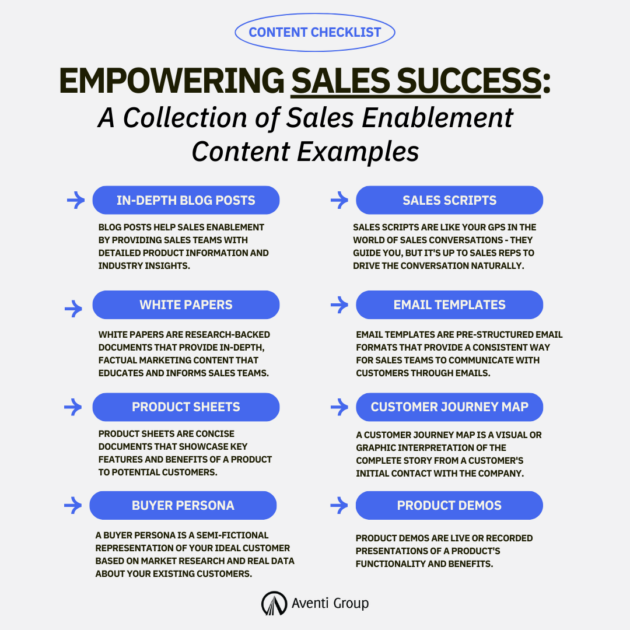Empowering Sales Success: A Collection of Sales Enablement Content Examples
Empowering Sales Success: A Collection of Sales Enablement Content Examples
42% of sales representatives report feeling underprepared before making a sales call.
Our collection of sales enablement content is designed to bridge this gap with the essential resources your sales team needs to succeed.
In this article, we will talk about different types of sales enablement content for guaranteed sales success.

In-Depth Blog Posts
Blog posts help sales enablement by providing sales teams with detailed product information and industry insights.
Imagine your company sells cutting-edge cybersecurity software. Your marketing team is gearing up to target mid-sized businesses increasingly concerned about data breaches.
However, they need deep, actionable knowledge to really connect with potential clients.
If your blog section has an article on “The 2023 Guide to Cybersecurity for Mid-Sized Businesses: Trends and Solutions”, things get much easier for sales reps.
They can discuss industry trends highlighted in the blog post, reference recent data breaches, and position your software as a timely solution.
Here are a few types of blog posts that can bolster your sales enablement content strategy:
- Industry Trends and Analysis
- FAQs
- Competitive Comparisons (Alternative Posts)
- Feature Updates and Enhancements
- Thought Leadership Pieces
- Case Studies
- How-To Guides for Products
- Customer Testimonials and Success Stories
- Market Research Findings
Sales Scripts
Sales scripts are like your GPS in the world of sales conversations – they guide you, but it’s up to sales reps to drive the conversation naturally.
For example, a sales rep at a tech company is pitching a project management tool. Sure, they’ve got a script, but it’s not a script they’re married to.
When they’re on a call with a client in the construction sector, they use the script as a baseline but adapt the conversation to focus on features like real-time updates and on-site coordination – key pain points for their client.
Our sales enablement services include creating tailored sales pitches that streamline communication and help you maintain a consistent brand voice.
Sales Scripts Template
“Good afternoon, Mr./Mrs./Miss [client’s surname]. My name is [agent’s name], and I’m calling from [company’s name]. We specialize in providing [type of products] that are particularly beneficial for businesses in [client’s industry]. I noticed some opportunities for [client’s company name] to enhance its [specific aspect related to the product, like efficiency, safety, customer satisfaction] with our products.
Do you have a few minutes to talk about how we can help you achieve these improvements?”
If they can’t talk now: “No problem at all. When would be a good time for us to discuss this briefly?”
If the answer is yes: “Great! To start with, our product [product name] can help your business by [mention a few specific benefits or solutions, such as reducing costs, improving quality, and streamlining operations]. This could be particularly advantageous for [a specific challenge or opportunity in their business].
[Move onto your pitch]
I understand that these decisions require careful consideration. I’ll email you shortly with all the details we discussed, including some key benefits and how our product stands out. The email will also include a link to schedule a product demo at your convenience so you can see firsthand how our product works. May I have your email address, please?”
Let the customer respond.
“Thank you very much! I’ll send you that information shortly and look forward to our next conversation. Have a wonderful day!”
White Papers
White papers are research-backed documents that provide in-depth, factual marketing content that educates and informs sales teams.
Unlike blogs, white papers do not rely on direct persuasion or opinions. Instead, they effectively convince by presenting facts, evidence, real-life stories, and data-driven insights. The data can be in tables, charts, statistics, and infographics.
Examples of whitepapers include:
- Market Analysis Reports
- Technical Backgrounders
- Problem-Solution Guides
- Case Studies
- Industry Trend Overviews
- Best Practices Manuals
- Product Comparison Guides
- Business Impact Assessments
- Technology Adoption Roadmaps
Email Templates
Email templates are pre-structured email formats that provide a consistent and efficient way for sales teams to communicate with customers through emails.
Why are they important? They’re huge time-savers for sales enablement teams. Instead of crafting each email from scratch, you’ve got a template ready to personalize and send. They keep your messaging on-brand and consistent, pushing your potential customers down the sales funnel.
Types of email templates that can be prepared include:
- Initial contact
- Follow-ups
- Product update announcements
- Newsletters
- Thank you emails
- Event invitations
- Feedback requests
- Special offers
- Re-engagement emails
- Holiday or seasonal greetings
Product Sheets
Product sheets are concise documents that showcase key features and benefits of a product to potential customers.
They are superpowers for sales enablement success because they get straight to the point. At a glance, your customers see the top benefits and understand how your product solves their problems.
However, bombarding customers with every feature can backfire and complicate the buying process. You want to zero in on the top features – the ones your customers care about.
Customer Journey Map
A customer journey map is a visual or graphic interpretation of the complete story from a customer’s initial contact with the company through the various stages of engagement to a long-term relationship.
Some common stages in the buyer journey include:
- Awareness
- Consideration
- Purchase
- Service
- Loyalty
To maximize sales enablement potential, each stage should include the following elements:
- Customer Actions: What the customer does at each sales cycle stage.
- Touchpoints: Where and how customers interact with your brand.
- Emotions: How customers feel at each stage.
- Opportunities: Where sales teams can enhance the customer experience.
- Pain Points: Obstacles that prospective customers face that need to be addressed.
Buyer Persona
A buyer persona is a semi-fictional representation of your ideal customer based on market research and real data about your existing customers.
Here are a few things you can include in your ideal buyer persona:
- Demographic Information
- Job Title and Career Path
- Company Size and Industry
- Goals and Objectives
- Challenges and Pain Points
- Values and Fears
- Hobbies and Interests
- Communication Preferences
- Decision-Making Criteria
- Objections to Sales
- Role in Purchase Process
Product Demos
Product demos are live or recorded presentations of a product’s functionality and benefits. They serve as a practical tool for sales professionals to illustrate how a product works and how it can resolve a prospect’s specific challenges.
They’re especially pivotal, considering that 40% of potential buyers highlight product demonstrations as the most helpful factor in their decision-making process.
To make product demo videos more helpful for the sales process:
- Tailor to the Audience: Customize each demo to address the prospect or audience’s unique needs and pain points. You can also include relevant use cases that showcase the product’s impact in similar situations or industries.
- Highlight Key Features: Focus on the features that are most relevant to the prospect. Respect the prospect’s time by keeping the demo concise and to the point.
- Engage the Prospect: Encourage interaction by asking questions and inviting prospects to participate in the live demo.
- Follow-up: Provide additional resources after the demo and offer to answer any questions that may arise later.
- Gather Feedback: Use feedback from each demo to improve future presentations and understand customer needs better.
- Train Sales Team: Ensure that the sales team is well-trained and can answer in-depth questions about the product during the demo.
Conclusion
The strength of your sales enablement strategy could decide whether your leads convert. However, creating sales enablement tools requires expertise, a deep understanding of buyer psychology, and a commitment to quality that not every organization can manage internally.
At Aventi, we create the sales tools your team will actually want to use. Say goodbye to complicated jargon and hello to clear customer presentations, easy-to-use battle cards, straightforward sales playbooks, and scripts that get to the point.
Contact Aventi today to get started. Your sales success is waiting!





